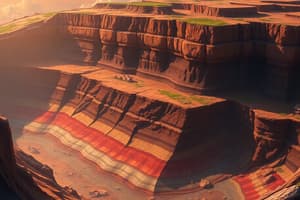Podcast
Questions and Answers
What is formed when sediments are compressed and hardened?
What is formed when sediments are compressed and hardened?
- Igneous rocks
- Metamorphic rocks
- Sedimentary rocks (correct)
- Molten magma
Granite is an example of a sedimentary rock.
Granite is an example of a sedimentary rock.
False (B)
What process transforms igneous and sedimentary rocks into metamorphic rocks?
What process transforms igneous and sedimentary rocks into metamorphic rocks?
Heat and pressure
The process of transformation of rock from one type to another is known as the __________.
The process of transformation of rock from one type to another is known as the __________.
Match the following types of rocks with their characteristics:
Match the following types of rocks with their characteristics:
Which of the following is an example of a game that uses stones?
Which of the following is an example of a game that uses stones?
Sediments are always transported by water only.
Sediments are always transported by water only.
Name one mineral that is commonly used as a fuel.
Name one mineral that is commonly used as a fuel.
What is the main mineral composition of the continental crust?
What is the main mineral composition of the continental crust?
The oceanic crust is thicker than the continental crust.
The oceanic crust is thicker than the continental crust.
What is the innermost layer of the Earth called?
What is the innermost layer of the Earth called?
When molten magma cools, it solidifies into __________ rocks.
When molten magma cools, it solidifies into __________ rocks.
Match the following types of rocks with their descriptions:
Match the following types of rocks with their descriptions:
Which layer of the Earth is called the mantle?
Which layer of the Earth is called the mantle?
Extrusive igneous rocks are formed from lava that cools rapidly on the Earth's surface.
Extrusive igneous rocks are formed from lava that cools rapidly on the Earth's surface.
The core is mostly composed of __________ and iron.
The core is mostly composed of __________ and iron.
Flashcards are hidden until you start studying
Study Notes
Earth's Structure
- Earth consists of several concentric layers: crust, mantle, and core, similar to an onion.
- The crust is the uppermost layer and is the thinnest, averaging 35 km thick on continental mass and 5 km on ocean floors.
- Continental crust, known as sial (silica + alumina), is primarily composed of silica and alumina.
- Oceanic crust, referred to as sima (silica + magnesium), consists chiefly of silica and magnesium.
- Below the crust lies the mantle, extending up to 2900 km in depth.
- The core, the innermost layer, has a radius of approximately 3500 km and is mainly composed of nickel and iron (nife).
Rocks and Minerals
- The earth's crust is made of various types of rocks, which are natural masses of mineral matter.
- Three major rock types exist:
- Igneous rocks are formed from cooled molten magma (primary rocks).
- Intrusive igneous rocks cool slowly within the earth, forming large grains (e.g., granite).
- Extrusive igneous rocks form rapidly on the surface from lava, resulting in a fine-grained structure (e.g., basalt).
- Sedimentary rocks are formed from compressed sediments transported by wind and water (e.g., sandstone), often containing fossils.
- Metamorphic rocks arise from igneous or sedimentary rocks subjected to heat and pressure (e.g., clay to slate, limestone to marble).
- Igneous rocks are formed from cooled molten magma (primary rocks).
Rock Cycle
- The rock cycle describes the transformation of one rock type into another.
- Igneous rocks can break down into sediments, which then form sedimentary rocks.
- When igneous and sedimentary rocks are subjected to high heat and pressure, metamorphic rocks form.
- Metamorphic rocks under sufficient heat and pressure can melt into molten magma, which can again solidify into igneous rocks.
Importance of Minerals
- Minerals are naturally occurring substances with specific physical properties and chemical compositions.
- Important for humanity: fuels (coal, natural gas, petroleum), industrial materials (iron, aluminum, gold, uranium), and medicinal uses (certain minerals and compounds).
- Minerals are crucial in agriculture, particularly in fertilizers.
Studying That Suits You
Use AI to generate personalized quizzes and flashcards to suit your learning preferences.




